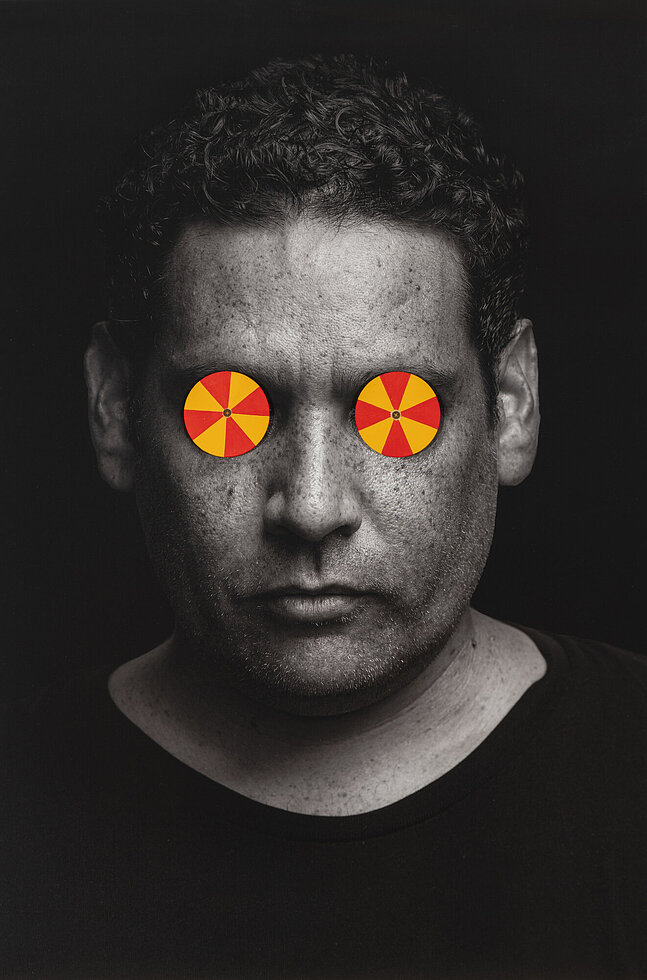
Tony ALBERT, ‘Aboriginal Art Hypnotherapy (AAH)’ (detail), digital print, spinning wheel device, 120.0 x 500.0 cm. Courtesy of the artist and Sullivan and Strumpf, Sydney. Photograph Michael Marzik.
FACELESS: Transforming Identity
Blak/Black Artists from North Australia, Africa and the African Diaspora
FACELESS Transforming Identity: Blak/Black Artists from North Australia, Africa and the African Diaspora is an exhibition that challenges established notions of identity and explores ways in which interpretations of identity can be manipulated or redefined by blak/black artists through a revisioning of the face using devices such as embellishment, erasure, and disguise.
Working closely with fifteen North Australian Aboriginal and Torres Strait Islander artists and ten African and African Diaspora artists, Cairns Art Gallery has curated this ground-breaking exhibition which brings together newly commissioned and loaned works across a range of art forms and media. For each artist, the physicality of the face, as a marker of identity, is explored and redefined within particular social, cultural, and political frameworks and contexts, to offer new meanings and interpretations.
For the artists in the exhibition the face is an important signifier of identity and by manipulating it or changing it in some way, they present more complex readings shaped by historical, political, and social contexts.
To support the exhibition the Gallery has commissioned two highly respected research/writers to contribute essays that offer alternative readings for the work of the artists included in the exhibition.
Dr Chelsea Watego (formerly Bond), a professor of Indigenous health at Queensland University of Technology Bond, has written an essay entitled More than the masks we wear, which offers multiple interpretations of issues that inform works by Aboriginal and Torres Strait Islander artists included in the exhibition. In her essay she writes,
I have always been interested in identity, and the disjuncture between what my body felt in its being, and how it has supposedly become known within the health sciences and humanities in which I labour.
…It would take me some time to come to understand the dispossessing function of identity in the colony, of never being enough, as either Black or Indigenous. But this is why I have been interested in the intellectual and political work of our artists who have the freedom to theorise about our world, how we came to be and know, without being bound by the disciplinary parameters so many of us have been trained in. And so, it’s the artists we turn to, to give expression to what we know about who we are as a people, not as a past people, or a lost culture, or as less than human, but as a people, fully human, here and now.
Renée Mussai is the Senior Curator and Head of Curatorial & Collections at Autograph, London, and guest curator and former fellow at the Hutchins Center for African & African American Research at Harvard University. Her essay explores complex readings of history and the relation of politics to identity and blackness, in order to ‘navigate the multiple frontlines of colour, both on the African continent and in its diaspora’.
In an excerpt from Renée Mussai’s essay entitled Afro-Camouflage: [Seeing With] Eyes Wide Open (working title) she raises questions about facelessness as an expression of identity, or lack of it,
Is being faceless akin to being without identity? …the artists from Africa and the African diaspora featured in Faceless – Transforming Identity adopt myriad creative methodologies to convey contemporary conditions of existence, cultivating artistic practices that speak from a multiplicity of positions and cultural spaces …Through imaginative modes of assemblage, performance and masquerade, they deconstruct, disrupt, dislocate – and reposition – conceptually, intellectually, aesthetically – collectively and individually.
…Explicit or implicit, facelessness is invoked in each of these ten artists’ positions in surprising, and disparate ways, evoking an assemblage of ‘representational potentialities’, to borrow the words of Hortense Spillers. Concealing and revealing, appealing and repealing, displacing and replacing, refuting and disputing, they use strategies of masquerade and disguise as both protective and retractive forces
Both writers acknowledge that the artists represented in the exhibition individually delve into shared experiences, issues, and narratives of the black/blak experience, and that the works that they have created are deeply personal and informed by memories and lived experiences that demonstrate, in the words of Chelsea Watego Bond, ‘to be faceless is not by any means to be powerless.’
Exhibition Publication
The Gallery has commissioned two highly respected researchers/writers who have contributed insightful essays that explore and present more complex readings of the self, in the contexts of shared and unique histories and cultures.
Aboriginal and Torres Strait Islander Artists
Vernon Ah Kee
Kim Ah Sam
Tony Albert
Simone Arnol
Destiny Deacon
Janet Fieldhouse
Fiona Foley
Naomi Hobson
Glen Mackie
Shirley Macnamara
BJ Murphy
Brian Robinson
Obery Sambo
Alick Tipoti
Dr Christian Thompson AO
Africa and the African Diaspora Artists
Xaviera Simmons
Edson Chagas
Leonce Raphael Agbodjelou
Namsa Leuba
Lakin Ogunbanwo
Kiluanji Kia Henda
Gerald Machona
Cyrus Kabiru
Nyaba Leon Ouedraogo
Sethembile Msezane
SOURCE: Cairns Art Gallery.